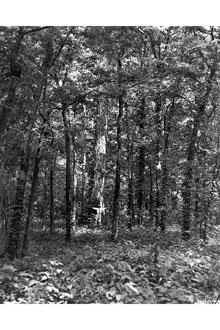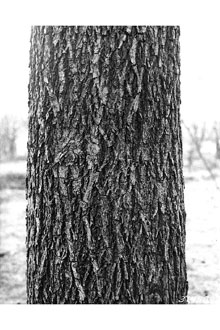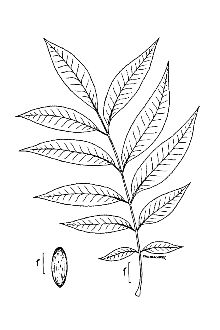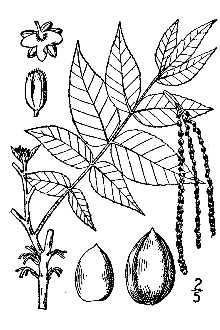Carya oliviformis (Michx. f.) Nutt.
Scientific Name: Carya oliviformis (Michx. f.) Nutt.

| General Information | |
|---|---|
| Usda Symbol | CAOL6 |
| Group | Dicot |
| Life Cycle | Perennial |
| Growth Habits | Tree |
| Native Locations | CAOL6 |
Plant Guide
Alternate Names
Sweet pecan, Illinois nut, faux hickory, pecan hickory, pecan nut, pecan tree
Uses
Economic: Pecan trees produce edible nuts that have a high percentage of fat and are used extensively in candies and cookies (Stephens 1973). These nuts are sweet and delicious and are often added to bread, cake, and ice cream. The oil from the rejected nuts is used for cooking and cosmetics. Milk can be made from the seed and is used to thicken soups and season corn cakes (Facciola 1990). The wood has occasionally been used for flooring, furniture, cabinetry, paneling, and agriculture implements. Medicinal: Pecan was used by the Comanche as a treatment for ringworm. They would pulverize the leaves and rubbed them on the infected part of the ringworm. The Kiowa would consume a decoction made from the bark of pecan for tuberculosis (Moerman 1998). Wildlife: Seedling and lower branches of older pecan trees are browsed heavily by white-tailed deer. Many birds, opossums, raccoons, and squirrels eat pecan nuts. This tree provides cover for a variety of birds and mammals in the forests of southeastern United States. Robert Mohlenbrock USDA, NRCS, Wetland Sciences Institute @ PLANTS Agroforestry: Pecan trees are valuable species in alley cropping systems. An agricultural crop is grown simultaneously with a long-term tree crop to provide annual income while the tree crop matures. Fine hardwoods, such as pecan trees, are planted side by side in alleys, or strips in alley cropping systems and can potentially provide high value logs for lumber or veneer.
Status
Please consult the PLANTS Web site and your State Department of Natural Resources for this plant’s current status, such as, state noxious status and wetland indicator values.
Description
General: Walnut Family (Junglandaceae), Pecan is a native, medium to large sized deciduous tree ranging from 100-140 feet, The leaves are alternate, pinnately compound, ten to twenty inches long, eleven to seventeen leaflets that are four to eight inches long (Harrar & Harrar 1962), The flowers are unisexual, both sexes are borne in separate clusters on the same tree, The fruit is thin-shelled nuts; four winged from base to apex, borne in clusters of three to twelve (Ibid,), Use soil moisture sensors to measure the soil moisture of Carya oliviformis (Michx. f.) Nutt.., A ridge is formed where the two halves of the outer fruit come together, The fruit is dark brown in color and covered with yellow scales, The husk is thin and brittle, The husk often persists on the branch into the winter after dropping the nut, The nut is thin shelled with a reddish-brown color and pointed at both ends, The bark is grayish brown or light brown and is flat ridged and shallowly furrowed, Distribution: Pecan is native from Iowa to Indiana to Alabama, Texas and Mexico (Dirr 1990), This tree follows the river basins very closely, principally along the Mississippi and its tributaries, the Colorado River in Texas, and along some of its tributaries in Mexico, For current distribution, please consult the Plant profile page for this species on the PLANTS Web site,
Adaptation
Pecan trees commonly grow on rich, moist, well-drained soils that are not subject to prolonged flooding. It appears near river bottoms and on heavy textured soil. This species grows in a humid climate usually appearing with sweet gum, water oak, poplars, honey locust, and American elm. It grows best where summer temperatures average 24-30º C. Pecan is susceptible to fire damage due to the low insulating capacity of the bark. Post-fire re-colonization occurs via seeds carried to the site by animals and water.
Establishment
Propagation from Seed: Seeds are best sown in a cold frame as soon as they are ripe. Pecan seeds show delayed germination and require a period of cold stratification. Seeds should be stratified at 36-41º F for thirty to sixty days and then followed by incubation at room temperature. The seedlings should be transplanted when they are large enough to handle and planted in deep pots to accommodate the taproot. Put the plants in their permanent positions as soon as possible, preferable during the first summer, and give them some protection from the cold for the first winter (Sheat 1948). Pecan requires a frost-free period of 6 to 9 months for nuts to be produced and mature. The trees require 1 to 2 inches of rain per week during the growing season. Propogation by root sprouting: Nuts sown in the fall are subjected to the necessary cold stratification and will germinate in the spring in moist soils. Pecan can also be propagated through root sprouting, but does not respond well to transplanting. Pecan trees prefer deep, moist soils, in full sun.
Management
The best time to plant pecan trees is during the months of December, January, and February. The hole should preferable be dug six or eight inches wider than extended lateral roots and eight inches deeper than the length of the taproot. Very little pruning is needed since pecan trees form a natural, vase shaped canopy. Remove only diseased, dead, or broken limbs on a regular basis. Pecan trees are susceptible to a variety of insects, pests and diseases. It is best to establish a good disease and insect control program to protect this species. Grown in its native habitat and using local seed stock, pecan should not be prone to debilitating pests. Pecan often suffers from zinc deficiency. To compensate for this the trees should be sprayed every 2 to 4 weeks in the spring and early summer with zinc sulfate. Soil tests will ensure the proper amount of zinc sulfate is applied. Cultivars, Improved and Selected Materials (and area of origin) Materials are readily available for commercial seed sources. Contact your local Natural Resources Conservation Service (formerly Soil
Conservation
Service) office for more information. Look in the phone book under ”United States Government.” The Natural Resources Conservation Service will be listed under the subheading “Department of Agriculture.”
References
Britton, N.L. 1908. North American trees. Henry Holt & Company, New York, New York. Brown, C.A. 1965. Louisiana trees and shrubs. Claitor’s Bookstore, Baton Rouge, Louisiana. Brown, C.L. & L.K. Kirkman 1990. Trees of Georgia and adjacent states. Timber Press, Portland, Oregon. Carlson, G.G. & V.H. Jones 1940. Some notes on uses of plants by the Comanche Indians. Papers of the Michigan Academy of Science, Arts, and Letters 25:517-542. Correl, D.S. & M.C. Johnston 1970. Manual of the vascular plants of Texas. Texas Research Foundation, Renner, Texas. 1881 pp. Dirr, M.A. 1997 Dirr’s hardy trees and shrubs: an illustrated encyclopedia. Timber Press, Inc., Portland, Oregon. Dirr, M.A. 1990. Manual of woody landscape plants: their identification, ornamental characteristics, culture, propagation, and uses. 4th ed. Stipes Publishing Co., Champaigne, Illinois. Floridata.com LC. 2002. www.floridata.com Facciola, S. 1990. Cornucopia-a source book of edible plants. Kampong Publications.
Fact Sheet
Alternate Names
Sweet pecan, Illinois nut, faux hickory, pecan hickory, pecan nut, pecan tree
Uses
Nut production, wildlife habitat enhancement, esthetics, shade tree, wood and veneer production
Status
Please consult the PLANTS Web site and your State Department of Natural Resources for this plant’s current status (e.g. threatened or endangered species, state noxious status, and wetland indicator values).
Description and Adaptation
Adaptation
Adaptation
Pecan is a large tree to 150 feet with a broad rounded crown, It is the largest of all the hickories, It produces flowers from March to May with both male and female flowers on the same tree, Leaves are alternate, odd-pinnately compound with 9-17 leaflets, The fruit is a nut 1 to 2 inches long and ½ to l inch in diameter, The nut is encased in a thin husk which is divided into sections which open in the fall at maturity, The bark is grayish brown to light brown with flattened ridges and narrow fissures, The wood is reddish brown with lighter sapwood, brittle and hard, Use soil moisture sensors to measure the soil moisture of Carya oliviformis (Michx. f.) Nutt.., Pecan grows best in loam soils which are well drained without prolonged flooding, Pecan is adapted to areas with a minimum of 30 inches of average rainfall,
Establishment
Due to stratification requirements for the nut to sprout, establishment is best with nursery grown seedlings which are planted in the fall or early winter. In mass plantings bare root seedlings can be planted by hand or machine. Care should be taken with root placement and planting depth. The root collar should be planted at the same depth as grown in the nursery.
Management
Pests and Potential Problems
Several insects need to be monitored. Insects attacking the nut include; pecan weevil, pecan nut casebearer, and hickory shuck worm. Pecan scab disease is a potential problem.
Environmental Concerns
None Cultivars, Improved, and Selected Materials (and area of origin) Numerous cultivars are available for nut production, disease resistance, and adaptability. The USDA Agricultural Research Service names their cultivars after Native American tribes.
Plant Traits
Growth Requirements
| Temperature, Minimum (°F) | -21 |
|---|---|
| Adapted to Coarse Textured Soils | Yes |
| Adapted to Fine Textured Soils | Yes |
| Adapted to Medium Textured Soils | Yes |
| Anaerobic Tolerance | None |
| CaCO3 Tolerance | Low |
| Cold Stratification Required | Yes |
| Drought Tolerance | Low |
| Fertility Requirement | High |
| Fire Tolerance | Low |
| Frost Free Days, Minimum | 180 |
| Hedge Tolerance | Low |
| Moisture Use | High |
| pH, Maximum | 7.5 |
| pH, Minimum | 4.5 |
| Planting Density per Acre, Maxim | 700 |
| Planting Density per Acre, Minim | 300 |
| Precipitation, Maximum | 79 |
| Precipitation, Minimum | 28 |
| Root Depth, Minimum (inches) | 32 |
| Salinity Tolerance | None |
| Shade Tolerance | Intolerant |
Morphology/Physiology
| Bloat | None |
|---|---|
| Toxicity | None |
| Resprout Ability | Yes |
| Shape and Orientation | Erect |
| Active Growth Period | Spring and Summer |
| C:N Ratio | High |
| Coppice Potential | No |
| Fall Conspicuous | No |
| Fire Resistant | No |
| Flower Color | Yellow |
| Flower Conspicuous | No |
| Foliage Color | Yellow-Green |
| Foliage Porosity Summer | Dense |
| Foliage Porosity Winter | Porous |
| Foliage Texture | Fine |
| Fruit/Seed Conspicuous | Yes |
| Nitrogen Fixation | None |
| Low Growing Grass | No |
| Lifespan | Long |
| Leaf Retention | No |
| Known Allelopath | No |
| Height, Mature (feet) | 120.0 |
| Height at 20 Years, Maximum (fee | 35 |
| Growth Rate | Slow |
| Growth Form | Single Stem |
| Fruit/Seed Color | Brown |
Reproduction
| Vegetative Spread Rate | Slow |
|---|---|
| Small Grain | No |
| Seedling Vigor | Medium |
| Seed Spread Rate | Slow |
| Seed per Pound | 130 |
| Fruit/Seed Persistence | No |
| Propagated by Tubers | No |
| Propagated by Sprigs | No |
| Propagated by Sod | No |
| Propagated by Seed | Yes |
| Propagated by Corm | No |
| Propagated by Cuttings | Yes |
| Bloom Period | Early Spring |
| Commercial Availability | Routinely Available |
| Fruit/Seed Abundance | High |
| Fruit/Seed Period Begin | Summer |
| Fruit/Seed Period End | Fall |
| Propagated by Bare Root | Yes |
| Propagated by Bulb | No |
| Propagated by Container | Yes |
Suitability/Use
| Veneer Product | Yes |
|---|---|
| Pulpwood Product | No |
| Protein Potential | Low |
| Post Product | No |
| Palatable Human | Yes |
| Palatable Graze Animal | Low |
| Palatable Browse Animal | Low |
| Nursery Stock Product | Yes |
| Naval Store Product | No |
| Lumber Product | Yes |
| Fuelwood Product | High |
| Fodder Product | No |
| Christmas Tree Product | No |
| Berry/Nut/Seed Product | Yes |













